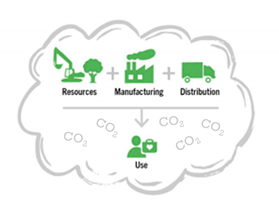The Materials-Climate Nexus

StopWaste works with cities and communities to focus on upstream activities that target "reduce" and "reuse" in the waste reduction hierarchy. Waste prevention strategies not only reduce the amount of waste going to landfills but also prevent embodied emissions in materials by reducing wasteful (excessive or inefficient) material production and consumption.
The Materials-Climate Nexus
According to UC Berkeley’s Cool Climate Network, the average carbon footprint of a household in Alameda County is 43 metric tons of carbon dioxide equivalent (CO2e). Global climate leaders including the State of California indicate that per capita emissions need to be lower than two tons CO2e by 2050. About 45 percent of these emissions are related to materials. These activities, such as growing food, making new products, shipping goods to market, the energy we use while consuming goods, and the impacts of discards are referred to as lifecycle, upstream, embedded, or "embodied emissions." Read the Climate Action and Embodied Emissions Topic Brief to learn more about embodied carbon.
Local Government Climate Action Planning
StopWaste helps communities understand their consumption-based emissions by supporting their inclusion in local government climate action plans. Click here for templates, guidance, and links to other resources related to consumption-based emissions inventories.
See below for descriptions and links to our upstream waste prevention programs that have an embodied emissions co-benefit.
Organics
StopWaste’s current projects have a large focus on organics. There is significant GHG reduction potential for addressing organic material throughout its lifecycle.
 Composting - StopWaste has promoted backyard and commercial composting for decades. More recently, the Mandatory Recycling Ordinance has made commercial compost collection a requirement for businesses and multifamily housing. Composting food waste results in about 0.39 tons of CO2e fewer emissions than landfilling.
Composting - StopWaste has promoted backyard and commercial composting for decades. More recently, the Mandatory Recycling Ordinance has made commercial compost collection a requirement for businesses and multifamily housing. Composting food waste results in about 0.39 tons of CO2e fewer emissions than landfilling.
Reducing Food Waste – the StopFoodWaste campaign educates residents on smart planning and storage can help reduce food waste. The Smart Kitchen Initiative provides training and tools to institutional kitchens that handle a high volume of food. Moving upstream to preventing wasteful food habits in the first place potentially avoids emissions related to the whole production and supply chain in addition to landfill emissions. These can total an average 2 tons of CO2e avoided per tons of food waste prevented.
Healthy Soils – bringing the organics cycle food circle means applying compost and mulch to soil, which offers many benefits including GHG reduction. It stops soil erosion which prevents about 0.08 tons of CO2e just by keeping the carbon stored in the soil. Compost further allows the soil to sequester additional carbon, approximately 1 ton CO2e per hectare of applied land per year, with as little as a half inch layer of compost. Creating healthy soils with compost also reduces the need for synthetic fertilizers and the GHG emissions associated with them, at about 0.15 tons CO2e per ton of compost applied. Healthy, organic soils also promote drought tolerance and crop resiliency which will be important in preparation for climate change impacts. StopWaste is partnering on a carbon farming project on our rangeland property in the Altamont Hills east of Livermore to test how a thin layer of compost can fight climate change by capturing carbon from the atmosphere and storing it in the soil.
To read more about the GHG impacts of organics management visit the California Air Resources Board website: https://www.arb.ca.gov/cc/waste/cerffinal.pdf
Packaging
StopWaste addresses packaging through several projects that focus upstream, helping to prevent, reuse, and improve the recyclability of packaging materials manufactured, sold, and discarded in Alameda County.
Reusable Bag Ordinance – Since 2013, grocery stores and certain other food retailers in Alameda County have not been allowed to provide single-use plastic carryout bags at checkout, and the results have been great for the local environment. Recently, the ordinance, expanded to cover all types of retail stores and restaurants. The new requirements will go into effect on May 1st, 2017 for retail stores, and November 1, 2017 for restaurants.
Use Reusables campaign offers educational resources, expert advice, and grants to help businesses switch to durable, reusable transport packaging. This reduces the number of disposable wood pallets, cardboard boxes, and stretch wrap generated by businesses in Alameda County, and results in lower energy use and total GHG emissions.
Packaging Design and Labeling - StopWaste works with local consumer products companies to optimize packaging design, employ life-cycle thinking to packaging decisions, and choose labeling that supports recycling, such as the How2Recycle label.
Reduce Disposable Food Ware – Through the Rethink Disposable program, StopWaste supports businesses and schools with rebates and assistance for the transition to reusable food ware, and introduces other practices that prevent waste in food service.
Built Environment
StopWaste is an Ellen MacArthur Foundation Circular Economy 100 USA member. As a member, we are undertaking a circular economy project in the built environment sector. We partnered with Arup to explore the role of local governments in increasing the circularity of the built environments within their jurisdictions. Read the primer: Circular Economy in the Built Environment: Opportunities for Local Government Leadership.
StopWaste works with networks such as the Embodied Carbon Network (external) to advance policy options for local governments that decide to address embodied carbon in the built environment.
- Download 2 page summary of a recent conference session moderated by StopWaste staff: Carbon Smart Building Day Embodied Carbon Policies (pdf)
- Watch recordings from a recent forum: bayrencodes.org/events (November 27, 2018)
According to CalRecycle’s 2008 Statewide Waste Characterization Study, construction and demolition (C&D) materials account for 29% of the waste stream. Every time C&D debris is sent to a landfill instead of recycling it, it contributes to methane from landfills. Read more under Climate Change on our C&D Resource page.